The all-purpose Asian stir-fry sauce prepared with various ingredients in the right proportion is the key to the wonderful flavor of stir-frying dishes. In this article, I will discuss the various seasoning ingredients used to constitute different stir-fry sauces for most Chinese cuisine.
Before I begin, I want to point out that some components of stir-fry sauces are also called sauce by themselves, for example, oyster sauce and light soy sauce.
Below are the five best stir-fry sauces on this blog:
1. Sauce for stir-fried eggplant, Sichuan style
This stir-fry sauce is originally used to stir-fry eggplants, Szechuan-style. It is also suitable for stir-frying other vegetables and minced meat.
2 tablespoons vegetable oil for frying
2 tablespoons chili bean paste or soybean paste for less spicy
1/2 teaspoon Sichuan peppercorn (optional)
1 tablespoon oyster sauce
1 tablespoon black vinegar
¼ teaspoon sugar
1 tablespoon Shaoxing wine (Optional)
The amount of this sauce is enough for 500 grams of eggplants plus one hundred 150 grams of minced meat.
2. Sauce to stir-fry Thai vegetables
This stir-fry sauce consists of golden mountain sauce and fish sauce which is the characteristic flavor of Thai stir-fries.
2 tbsp Golden Mountain sauce
2 tbsp fish sauce
2 tbsp oyster sauce
2 tsp sugar
2 tbsp water
This sauce is enough for 700 grams of Thai mixed vegetables.
3. Sauce for stir-frying beef noodles
This stir-fry sauce is my favorite sauce for any stir-fry noodles. I use it to stir-fry 250 grams of noodles plus 250 grams of beef. You can scale up or down the quantity accordingly.
1.5 tbsp oyster sauce
1 tbsp light soy sauce
1/2 tsp dark soy sauce
2 tsp sugar
1/4 tsp ground black pepper
2 tbsp water
4. The Thai minced pork stir-fry sauce
This sauce is typical for the Thai minced pork recipe Pad Kra Pao. The Thai bird’s eyes chilies are normally added to give it a hot and spicy flavor. The quantity below is for 400g of minced pork.
2 tbsp fish sauce
1.5 tbsp oyster sauce
1.5 tbsp light soy sauce
2 tsp dark soy sauce
2 tbsp sugar
Water
5. The teriyaki sauce
This teriyaki sauce is typical for Japanese stir-fries. You can use it to prepare either pork, chicken, or beef. I used the quantity below to stir-fry 500 grams of chicken breast meat.
3 tablespoons Japanese soy sauce
3 tablespoon mirin
3 tablespoon sake
1.5 tablespoon brown sugar
3 cloves of garlic, bashed
3 thick slices of ginger
2 tbsp water
The common ingredients of the stir-fried sauce
1. Soy sauce
There are two types of Chinese soy sauce, light soy sauce and dark soy sauce. The flavor of soy sauce varies from one brand to another. The best soy sauces are typically imported from Hong Kong, Japan, and China.
- The light soy sauce can be used as a dipping sauce for spring rolls or dim sum. It can also be part of the component for a stir-fry sauce.
- Dark soy sauce is normally used to marinate meat and to season noodle dishes, fried rice, and other stir-frying dishes. Dark soy sauce gives the dish a richer color and thicker texture.
2. Plum sauce
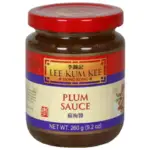
Plum sauce is a viscous, thick, gooey, light brown, sweet, and sour condiment. It is used in Chinese cuisine as a dip and as part of the marinade’s ingredients. Some plum sauce mixtures are cheese salad and sweet and sour chicken.
3. Oyster sauce
Oyster sauce is the second most popular sauce in Chinese cooking after soy sauce. It enhances the flavor of most dishes. It is a sauce that adds a savory flavor to any dish. This sauce is a staple for most Chinese home-style cooking. It is not fishy, taste universal, and is suitable for marinating and stir-frying poultry, meat, noodle, and rice. It is an essential element for stir-fried vegetables and a major component of the gravy for noodles. ( Lo Mien). Oyster sauce is also used as a topping for blanching vegetables.
Oyster sauce is also a major component of Thai and Cambodian cuisine. It imparts a fantastic aroma and flavor to any dish.
Since many Chinese are vegetarian, a vegetarian version of oyster source is also available. It is made with mushroom extract and has a flavor very close to the original oyster sauce.
4. Fish sauce
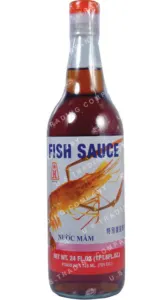
Fish sauce is the cornerstone of Vietnamese cooking. This amber-red sauce is very salty, and a little goes a long way. It is used as a condiment in many Asian cuisines.
This sauce can add depth to the flavor of any dish. It can be diluted with other ingredients to form a dipping sauce, be part of the ingredient of stir-fry sauce, and marinate meat. It is also used to prepare the sauce for Thai steamed fish along with shallot, chili, tamarind, and lime. Some Chinese also use fish sauce in their cooking, although soy sauce is more popular in the Chinese community.
5. Sesame oil
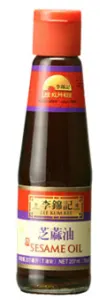
Sesame Oil is a flavorful, dark, and aromatic oil. It has a strong, distinctive, slightly sweet, nutty flavor due to toasting the seeds during production. Sesame seed oil is an integral component of Asian food.
It is not for use as a cooking oil as the flavor is too intense and has a low smoking point. It is generally used for Chinese cooking, such as marinade and frying. It is also used as a flavoring agent in the final stages of cooking, for example, sprinkled a few drips at the end of a bowl of soup noodles. The flavor is strong. Therefore, “a little goes a long way” describes sesame oil perfectly.
Sesame oil is a vegetable oil derived from sesame seeds. It is often used as a flavoring agent in Chinese, Japanese, Korean, and other Southeast Asian cuisines.
6. Ketchup

Ketchup normally refers to tomato ketchup, with is synonymous with tomato sauce. It contains not just tomato, vinegar, and other seasonings. Tomato ketchup is used in fast food dishes such as hot dogs, hamburgers, and a large variety of Asian food.
Many gravies for Asian dishes contain tomato ketchup. For example, sweet and sour sauce of Chinese origin and ayam masak merah (Malay style tomato curry chicken) use plenty of tomato ketchup in the recipes. It is also used as a dipping sauce in the Indonesian and Chinese communities.
7. Five-spice powder
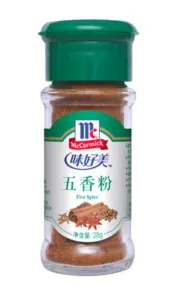
Five spices powder consists of ground peppercorns, star anise, cloves, fennel and cinnamon, and sometimes coriander powder. It is a versatile spice mix that is suitable to season a variety of meat and poultry. The composition of each brand of five spices powder may not be the same. The difference can be either the ratio of the spices or, in some cases, a different combination apart from the above-mentioned. For instance, some manufacturers include cardamom, Szechuan peppercorn, and nutmeg in the spice mix.
The five-spice powder adds a spicy kick to marinades and dry rubs for meat and poultry. It goes particularly well with stew pork – a traditional pork belly dish called “Five Flower Pork.” It is also used in a minute amount in the famous barbecue pork bun called Char Siu Bao. Some other common usage of five spices powder is to marinate fried chicken.
8. Worcestershire sauce
Worcestershire is not the traditional ingredient for Asian cuisine but has gained popularity as it is compatible with most other Asian ingredients. Lamb marinated with Worcestershire sauce, oyster sauce, soy sauce, and tomato ketchup has a fantastic flavor. You can also use it with oyster sauce and sugar to coat the prawns in the dish called Cantonese pan-fried prawns.
Stir-fry sauces from different Asian countries
- China is where the technique of stir-frying originated. Therefore, most of the popular stir-fried dishes and the respective stir-fry sauces originated in China. The basic elements that most Chinese cuisines are light soy sauce, dark soy sauce, sesame oil, and oyster sauce. For example, sweet and sour chicken contains various ingredients in the sauce.
- Thai stir-fry sauce usually contains fish sauce in combination with light soy sauce. Thai sauces are different from Chinese sauces as they combine sweetness, saltiness, sourness, and spiciness. Classic Thai sauce includes bird’s eye chili, lime juice, sugar, and tamarind.
- As for Malaysian Chinese cuisine, it incorporates local ingredients such as chili and coconut with excellent stir-fried techniques from China. An example is Kam Heong stir fry sauce for crabs and other seafood. Local ingredients such as dry shrimp and curry leaves are the local ingredients used to cook with the traditional Chinese cooking method.
- Teriyaki is a Japanese stir fry sauce containing light soy sauce, mirin (sweetened rice wine), sugar, and honey or sugar. All the ingredients are combined and boiled until reduced to the desired consistency.
Make A Batch Of Your Own Stir Fry Sauce
However, the choice is yours as it can be interchanged. Try to experiment with all these combinations and settle on the one you prefer. You can make a bigger batch to keep for your next stir-fry dish.
If you visit any Asian restaurant, you may notice some chefs never premix sauces, as I mentioned here. Instead, they have all the components of the sauce (soy sauce, sesame oil, oyster sauce, salt, sugar, etc.) placed in individual containers beside the stove. They will pick all the components with a small spoon, place them in a ladle, and constitute the sauce whenever needed. Whilst this method has the advantage of letting the person cook have full control of what components (and how much) to be included, it also has its intrinsic pitfalls – the possibility of omitting some components or unintentionally including the wrong quantity. This commonly happens as the quantity for each component is relatively small (some are perhaps 1/4 of 1/8 teaspoon), and the types of components can be more than five at times. Therefore, unless you are already proficient with the characteristic of each component, you may want to stick to the three stir-fry sauces in this section.
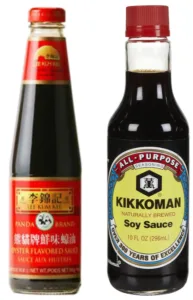

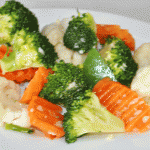
Joy
Friday 31st of March 2023
Very helpful exploration of various Asian stir fry sauces. After consulting the most prominent, "easily Googled" blogs and YouTube channels I found this page. A helpful tutorial to myself as a newbie. (what I hope to say is a westerner of Italian and Polish decent that has been enthusiastically spending hours in the kitchen the past five years trying to learn this cuisine). Super helpful!
Carol Vo
Sunday 1st of August 2021
Wow, Just made sauce b but halved the ingredients and I love it already!!! Is there a specific way to store the sauce?How long will it last? My partner and I have moved to a different state so there are only 2 of us eating.
Note: Please use very little sauce to begin with, as others have found it salty... I did not...
Thanks Chef!!!
KP Kwan
Sunday 1st of August 2021
I suggest you keep the sauce in small freezer-safe containers. Then keep them in a small box then stuff them with some paper to secure them. Keep in the freezer and remove it only when you start your journey. I did that before, and it did not melt even after 12 hours. Each container is for one portion, so you only need to defrost one for each cooking next time. It can be kept in the freezer for up to two months with no noticeable flavor deterioration.
Lim Kian Hin
Monday 5th of February 2018
Dear Mr Kwan.
The amount of premix sauce. 15 percent on example cooked Rice. FYI. . I do hv a digital weigh machine. Prepare accordingly to recipe. Found 15 percent was too much salty. I preferred to use less than 10 percent.
Then your other video on Fried Rice. The fried rice premix was not used. Just a Good Quality Soya Sauce.
So fried rice is sauce used is just preferences. Either way can do. ?
KP Kwan
Monday 5th of February 2018
The sauce (seasoning) for fried rice can be different from one recipe from another. My recipe is what I use but make it your own by changing it according to you need. Good quality soy sauce will give a better result. If you follow my post Chinese fried rice, you should be able to find more information on the fundamental technique to prepare it.
Thanks,
KP Kwan
CY
Thursday 18th of January 2018
Dear KP, When I saw the ingredients for the sauces I thought it was godsend until I tried a small batch at ratio of 0.25. I would have thought it would be salty considering the sodium already in the individual sauces. True enough it is indeed salty! Could you please advice how to use them as in dilution or add sugar per tablespoon spoon of the sauce?
KP Kwan
Thursday 18th of January 2018
Hi CY,
Just to recap the formula is: 2 teaspoons of salt 1.5 teaspoon of sugar 2 tablespoons of oyster sauce 1/2 teaspoon of cornflour A dash (about 1/8 teaspoon) of ground white pepper 4 tablespoons of water
So this is going to be salty if you taste it as it is. It will be just right if you use it to mix/fry with 1kg of vegetable (only the edible part after cutting and washed). The only ingredient that is salty is the oyster sauce, so if you want to be less salty, just keep everything unchanged, but reduce 2 teaspoons of salt to 1 1/2 teaspoons.
In any case, if you want to make changes, you may add some light soy sauce (reduce the salt of course) and a few drops of sesame oil.
Hope this will suit your taste.
Thanks,
KP Kwan
CJ Savvy
Friday 17th of February 2017
Dear sir,
I'm glad I found your site while searching for stir fried dishes. These are the kind of dishes I wanted to impress my wife with. I'm not Chinese but enjoy eating various Chinese dishes. Thank you for sharing these recipes and cooking techniques. I will try to cook them as best as I can.
KP Kwan
Saturday 18th of February 2017
Dear CJ, Thank you and hope you enjoy your cooking.
Best regards,
KP Kwan